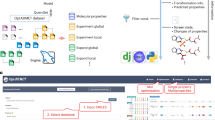Abstract
The results of a new method developed to identify well defined structural transformations that are key to improve a certain ADME profile are presented in this work. In particular Naïve Bayesian statistics and SciTegic FCFP_6 molecular fingerprints have been used to extract, from a dataset of 1,169 compounds with known in vitro UGT glucuronidation clearance, those changes in chemical structure that lead to a significant increase in this property. The effectiveness in achieving that goal of the thus found 55,987 transformations has been quantified and compared to classical medicinal chemistry transformations. The conclusion is that on average the new transformations found via in silico methods induce increases of UGT clearance by twofold, whilst the classical transformations are on average unable to alter that endpoint significantly in any direction. When both types of transformations are combined via substructural searches (SSS) the average twofold increase in glucuronidation is maintained. The implications of these findings for the drug design process are also discussed, in particular when compared to other methods previously described in the literature to address the question ‘Which compound do I make next?’



Similar content being viewed by others
Abbreviations
- ADME:
-
Absorption distribution metabolism and excretion
- QSAR:
-
Quantitative structure–activity relationships
- UGT:
-
Uridine 5’-diphospho-glucuronosyltransferase
- ECFP:
-
Extended connectivity finger-prints
References
Lipinski CA, Lombardo F, Dominy BW, Feeney PJ (2001) Experimental and computational approaches to estimate solubility and permeability in drug discovery and development settings. Adv Drug Deliv Rev 46:3–26
Martin YCA (2005) Bioavailability score. J Med Chem 48:3164–3170
Leach AG, Jones HD, Cosgrove DA, Kenny PW, Ruston L, MacFaul P, Wood JM, Colclough N, Law B (2006) Matched molecular pairs as a guide in the optimization of pharmaceutical properties; a study of aqueous solubility, plasma protein binding and oral exposure. J Med Chem 49:6672–6682
SciTegic, Inc. (a wholly-owned subsidiary of Accelrys, Inc.), 10188 Telesis Court, Suite 100, San Diego, CA 92121-4779, USA, Pipeline Pilot 7.5, 2008, version 7.5, www.scitegic.com
Uchaipichat V, Winner LK, Mackenzie PI, Elliot DJ, Williams JA, Miners JO (2006) Quantitative prediction of in vivo inhibitory interactions involving glucuronidated drugs from in vitro data: the effect of fluconazole on zidovudine glucuronidation. Br J Clin Pharmacol 61:427–439
Xia X, Maliski EG, Gallant P, Rogers D (2004) Classification of kinase inhibitors using a Bayesian model. J Med Chem 47:4463–4470
Rogers D, Brown RD, Hahn M (2005) Using extended-connectivity fingerprints with Laplacian-modified Bayesian analysis in high-throughput screening follow-up. J Biomol Screen 10:682–686
Nidhi, Glick M, Davies JW, Jenkins JL (2006) Prediction of biological targets for compounds using multiple-category Bayesian models trained on chemogenomics databases. J Chem Inf Model 46:1124–1133
Hert J, Willett P, Wilton DJ, Acklin P, Azzaoui K, Jacoby E, Schuffenhauer A (2006) New methods for ligand-based virtual screening: use of data fusion and machine learning to enhance the effectiveness of similarity searching. J Chem Inf Model 46:462–470
Sun HA (2005) Naive Bayes classifier for prediction of multidrug resistance reversal activity on the basis of atom typing. J Med Chem 48:4031–4039
Stewart KD, Shiroda M, James CA (2006) Drug Guru: a computer software program for drug design using medicinal chemistry rules. Bioorg Med Chem 14:7011–7022
Lewis M, Cucurull-Sanchez L (2009) Structural pairwise comparisons of HLM stability of phenyl derivatives: introduction of the Pfizer metabolism index (PMI) and metabolism-lipophilicity efficiency (MLE). J Comput-Aided Mol Des 23:97–103
Sheridan RP, Hunt P, Culberson JC (2006) Molecular transformations as a way of finding and exploiting consistent local QSAR. J Chem Inf Model 46:180–192
Lewis RAA (2005) General method for exploiting QSAR models in lead optimization. J Med Chem 48:1638–1648
Wolohan PRN, Akella LB, Dorfman RJ, Nell PG, Mundt SM, Clark RD (2006) Structural unit analysis identifies lead series and facilitates scaffold hopping in combinatorial chemistry. J Chem Inf Model 46:1188–1193
Hajduk PJ, Sauer DR (2008) Statistical analysis of the effects of common chemical substituents on ligand potency. J Med Chem 51:553–564
Wagener M, Lommerse JPM (2006) The quest for bioisosteric replacements. J Chem Inf Model 46:677–685
Patani GA, LaVoie EJ (1996) Bioisosterism: a rational approach in drug design. Chem Rev 96:3147–3176
Olesen PH (2001) The use of bioisosteric groups in lead optimization. Curr Opin Drug Discov Devel 4:471–478
Wermuth CG, Camille GW (2003) Molecular variations based on isosteric replacements. In the practice of medicinal chemistry, 2nd edn. Academic Press, London, pp 189–214
Lima LM, Barreiro EJ (2005) Bioisosterism: a useful strategy for molecular modification and drug design. Curr Med Chem 12:23–49
Lewell XQ, Judd DB, Watson SP, Hann MM (1998) RECAP-retrosynthetic combinatorial analysis procedure: a powerful new technique for identifying privileged molecular fragments with useful applications in combinatorial chemistry. J Chem Inf Comput Sci 38:511–522
Southall N, Ajay T (2006) Kinase patent space visualization using chemical replacements. J Med Chem 49:2103–2109
Sheridan RP (2002) The most common chemical replacements in drug-like compounds. J Chem Inf Comput Sci 42:103–108
Haubertin DY, Bruneau PA (2007) Database of historically-observed chemical replacements. J Chem Inf Model 47:1294–1302
Lewell XQ, Jones AC, Bruce CL, Harper G, Jones MM, McLay IM, Bradshaw J (2003) Drug rings database with web interface. A tool for identifying alternative chemical rings in lead discovery programs. J Med Chem 46:3257–3274
Acknowledgments
The author thanks Marcel de Groot and Willem van Hoorn for useful discussions about pair wise comparisons and Bayesian statistics. She also thanks Chad Stoner, Inaki Morao and Willem van Hoorn for reviewing the manuscript and for their helpful suggestions.
Author information
Authors and Affiliations
Corresponding author
Electronic supplementary material
Below is the link to the electronic supplementary material.
Rights and permissions
About this article
Cite this article
Cucurull-Sanchez, L. Successful identification of key chemical structure modifications that lead to improved ADME profiles. J Comput Aided Mol Des 24, 449–458 (2010). https://doi.org/10.1007/s10822-010-9361-5
Received:
Accepted:
Published:
Issue Date:
DOI: https://doi.org/10.1007/s10822-010-9361-5




